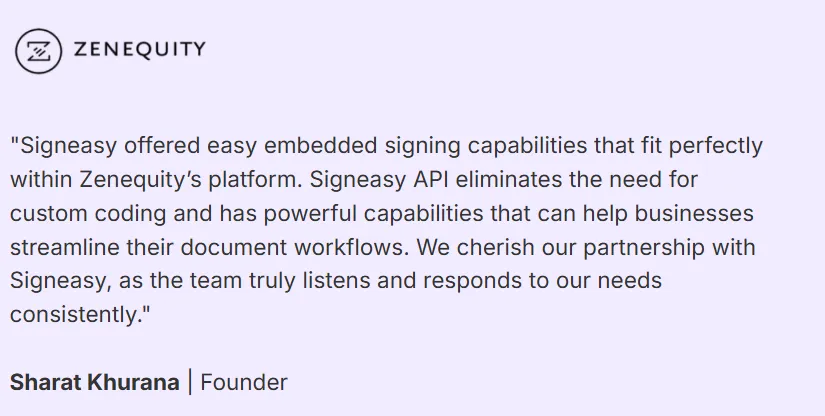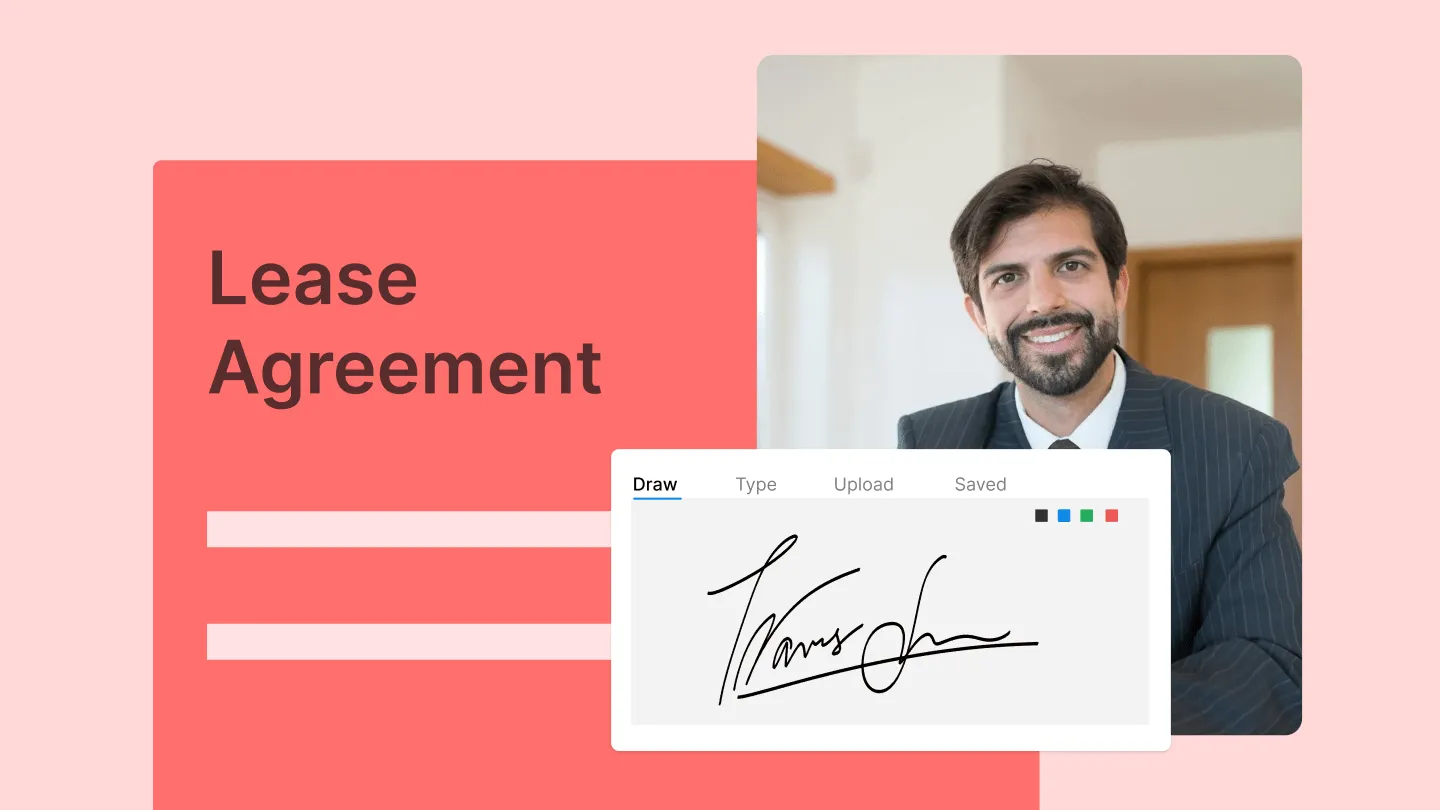Real estate electronic signature solutions are changing how agents handle transactions.
You know that moment when you’re about to finalize a deal (maybe with that hot lead you’ve been nurturing for weeks) and suddenly realize you still need to shuffle through a stack of paperwork or drive across town just to snag a couple of signatures?

It’s frustrating, and even worse, it gives your hard-earned prospect more time to reconsider, cooling off your once-red-hot lead.
Well, it wouldn’t be a hassle if it was a one-off case or you had to manage only one client. But real-estate firms need to manage multiple clients, get contracts and lease agreements signed daily, and store all the information securly.
With an electronic signature, you can secure those approvals quickly, without all the back-and-forth hassles. Instead of juggling schedules or chasing down clients, everything can be done online, from anywhere. This approach not only speeds things up, but also makes the entire experience more convenient for everyone involved.
Be it closing lease agreements, renewing tenant agreements, or onboarding a new client, eSignatures can minimize the turnaround time from weeks to days. According to the 2022 Technology Survey from the National Association of Realtors, 79% of the respondents said that eSignature has been one of the most important tools they used in their business.
But that’s not all. Real estate electronic signatures can help real estate businesses in many ways. In this article, we have talked about it in detail, so let’s get started.
How electronic signatures simplify real estate documents?
Before eSignatures arrived, finalizing real estate documents could feel like a never-ending task. Agents juggled massive stacks of paper, endured slow mailing times, and worried endlessly about whether every required signature was truly in place.
All these delays gave buyers and sellers room to reconsider their decisions. By the time you finally collected each signature, that once-hot lead might have cooled, slipping through your fingers despite all your hard work. Today, it is possible to sign pdf online free of cost, removing a major friction point and keeping the closing process efficient.
Real estate documents aren’t just a few pages. They can stretch for what feels like miles, filled with complex clauses that demand careful attention. With so many details, it was all too easy for someone to sign in the wrong spot or miss a critical line altogether.
When a signature was misplaced or mismatched, the entire packet risked rejection, forcing everyone back to square one. This repeat cycle consumed time, tested patience, and cost deals. Today, eSignatures eliminate these hurdles, transforming what was once a process into a streamlined digital experience that preserves leads and seals deals efficiently.
What are the benefits of real estate eSignatures
eSignatures simplify and modernize real estate transactions, offering speed, accuracy, and efficiency that manual processes simply can’t match.
Here are some benefits:
1. Faster deal closures
Finalizing real estate deals often hinges on getting documents signed quickly. The manual process of printing, mailing, and waiting for signatures slows everything down and risks losing momentum with clients. eSignatures solve this by enabling instant, remote signing.
Feature: Sending multiple documents in on go, real-time signing, and sequential workflows ensure documents are signed in order, keeping the process smooth and efficient.
2. Error-free document handling
Mistakes like missed signatures or incorrect placements can derail transactions and force time-consuming rework. eSignatures simplify this with guided workflows and automated prompts.
Feature: Signature prompts and field validation ensure every required field is accurately completed before submission.
3. Reusable templates for frequent transactions
Real estate transactions often involve similar documents, such as lease agreements or purchase contracts. Manually recreating these from scratch wastes time and effort. With eSignatures, you can create templates for frequently used documents, streamlining your workflow.
Feature: Pre-filled templates save time by eliminating repetitive tasks and reducing human error.
4. Enhanced security with digital certificates
Security is paramount in real estate, given the sensitive nature of contracts and client data. eSignatures use advanced encryption and digital certificates to ensure documents are tamper-proof and compliant with legal standards. You also get to download audit trails to document all actions.
Feature: Trust seals and digital certificates provide authenticity and peace of mind for all parties.
5. Convenient storage and retrieval
Managing stacks of physical paperwork can lead to misplaced documents and inefficient filing systems. eSignatures simplify this with centralized digital storage, allowing you to access contracts anytime.
Feature: A secure, searchable repository makes it easy to retrieve signed documents in seconds.
6. Keeping everyone in the loop
In real estate, it’s crucial to keep all stakeholders informed. eSignatures allow you to CC relevant parties and ensure transparency throughout the signing process.
Feature: Notifications and document tracking keep buyers, sellers, agents, and other stakeholders updated at every step.
7. AI-powered insights for smarter decisions
Today’s eSignature solutions go beyond just signing. With AI, they can analyze contracts instantly, go through key terms, clauses, or discrepancies to speed up reviews.
Feature: AI-powered contract summaries and key term extractions help agents and clients make informed decisions faster, reducing back-and-forth.
Who can use eSignature in real estate?
In the United States, eSignatures are widely accepted in real estate transactions, thanks to the Electronic Signatures in Global and National Commerce (ESIGN) Act of 2000 and the Uniform Electronic Transactions Act (UETA). These laws establish that electronic signatures are legally binding and have the same enforceability as traditional handwritten signatures, provided certain conditions are met.
Here’s who can use eSignatures in real estate and the types of documents they typically sign:
1. Real estate agents and brokers
Agents and brokers frequently handle agreements that require multiple signatures and approvals. eSignatures help streamline these processes and ensure timely completion.
Documents: Listing agreements, purchase agreements, disclosures, and addendums.
2. Buyers and sellers
eSignatures make it convenient for buyers and sellers to finalize transactions without needing to meet in person or deal with physical paperwork.
Documents: Purchase agreements, counteroffers, closing statements, and amendments.
3. Property managers and landlords
Property managers and landlords benefit from faster approvals for routine paperwork, enabling smoother operations and tenant onboarding.
Documents: Lease agreements, rental contracts, property inspection forms, and tenant notices.
4. Lenders and title companies
These parties rely on eSignatures to expedite the financial and legal aspects of real estate transactions while maintaining security and compliance.
Documents: Mortgage applications, loan agreements, title transfer documents, and escrow instructions.
5. Attorneys and legal advisors
Legal professionals use eSignatures to quickly process critical documents related to real estate transactions, reducing delays in closing deals.
Documents: Power of attorney, settlement statements, escrow agreements, and legal disclosures.
Who can’t use eSignatures in real estate?
While eSignatures are broadly accepted, some scenarios may limit their use:
1. Documents requiring notarization
Certain documents, such as property deeds, often require notarization. While Remote Online Notarization (RON) is growing in adoption, not all states accept it, and in-person notarization may still be required.
2. Wills and estate planning documents
Real estate documents tied to wills, trusts, or estate planning typically require traditional handwritten signatures due to state-specific legal requirements.
3. Non-compliant platforms
eSignatures must be completed using legally compliant platforms. If the chosen tool lacks security features like encryption, audit trails, or consent verification, the signatures may be invalid.
4. Disputes over consent
Under the ESIGN Act, all parties must explicitly agree to use eSignatures for the transaction. Without this consent, the signing process may be deemed invalid.
5. State-specific restrictions
Certain states may impose unique restrictions on high-value property transactions or require additional documentation that limits eSignatures’ applicability.
Features to look for in real estate electronic signature solution
Whether you want to lease a space, rent a room, sell land, or buy a property, a real-estate electronic signature solution can get the job done for you in minutes. However, with so many tools in the market, it can be overwhelming to choose the right tool.
Plus, it’s a big investment, and the stakes are really high. So, you must invest in the tool that's best for your business.
That’s why we have done all the hard work and curated this list of essential features to look for while investing in a real estate electronic signature solution.
1. Security and compliance
Do you know that 1.5 billion records were leaked in a data breach at Real Estate Wealth Network? It’s considered to be one of the biggest data breaches in 2023, where the personal information of property owners, sellers, and investors was exposed.
In real estate, every bit of information is sensitive, and data theft/breaches can lead to severe consequences.
So always opt for an eSignature tool that has strong security and compliance protocols in place. The tool should have a multi-factor authentication system, hardware tokens, secure digital signatures, and email verifications.
Next, the eSignature tool must adhere to the legal compliance requirement in your jurisdiction. So, pick a tool that adheres to laws like the E-SIGN Modernization Act in the US, Information Technology Act, 2000 in India, or eIDAS in the EU.
A tool that complies with enterprise-grade security protocols like SOC2 demonstrates the vendor’s commitment to data security.
Having a detailed audit trail that captures every step in the signing process can provide important evidence in case of any legal issues.
2. Integration with third-party tools
Imagine you’re working in your Google Workspace and can directly send a document for eSignature without having to leave the platform or toggle between multiple platforms. That’s the beauty of integration with third-party tools that save time and make the entire process efficient.
To make your operations smooth, you need an eSign tool that easily integrates with your existing tech stack, like Google Workspace, Microsoft, customer CRM, and other popular tools.
3. Status monitoring
If your document needs a sequence of signatures to be done by multiple stakeholders having the status monitoring feature can be immensely helpful.
This feature ensures timely follow-up and reduces the chance of delays. Many tools also send auto-reminders if any signature is pending with any particular stakeholder.
Status monitoring also alerts you when actions are taken on a document so you receive real-time updates.
4. Seamless mobile experience
With a seamless mobile experience you can close deals faster as customers can sign a document on the go. So choose a tool that works equally well across iOS and Android platforms.
For example, Signeasy has earned 4.2 stars on Google Play Store and 4.9 stars on Apple Store.


5. eSign API
Go for a tool that offers eSign API that enables users to sign and send contracts directly from your app.
For example, Signeasy APIs are easy to set up and integrate with a 99.9% uptime guarantee. It enables users to sign and send documents directly from any application.
Developers can embed Signeasy’s eSignature API within your app’s pop-up window, new tabs, web view, or iframe.

6. Templates for frequently used documents
Save time by creating reusable templates for contracts like listing agreements, purchase agreements, and lease forms. This eliminates repetitive tasks and ensures consistency across transactions.
7. Sequential and parallel signing options
Find tools that enable flexibility with signing workflows. Sequential signing ensures documents are signed in order, while parallel signing allows multiple parties to sign simultaneously, speeding up the process. This dual functionality ensures that regardless of the transaction's complexity, you always have the fastest way to sign a document online.
How’s Signeasy’s eSignature and contract management platform can help
Signeasy not only offers all the essential features like reusable templates, advanced security with digital certificates, centralized storage, sequential signing, CC options, and AI-powered contract review, but we go a step further with:
- Affordable and transparent pricing
Our pricing model is straightforward, ensuring you only pay for what you need—no hidden fees or surprises. - Great customer support
Our dedicated support team is always ready to assist, ensuring your questions are answered and your issues are resolved promptly. - An easy-to-use platform
Signeasy is designed with simplicity in mind, making it easy for agents and clients alike to navigate and use. This ensures a smooth experience from start to finish, enhancing productivity and satisfaction for everyone involved.
With Signeasy, you’re not just getting an eSignature tool; you’re getting a solution that combines robust features with affordability, exceptional support, and user-friendly design.










-min.png)
